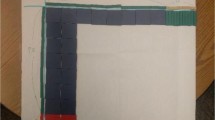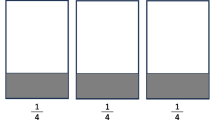Abstract
This study is an examination of 79 elementary prospective teachers’ (PSTs’) capacity for recognizing the core ideas involved in modeling fraction addition problems and their difficulties in solving and presenting the process of fraction addition using area, length, and set models. PSTs completed a written task in which they represented the process of solving a set of fraction addition problems of varying complexity in terms of the sizes of the addends, the sums, and the denominators using the three models. The PSTs’ responses to the task were analyzed and clustered to identify the most salient and recurring patterns of erroneous approaches to modeling. While the PSTs recognized the core ideas involved in modeling fraction addition problems, their actual work samples demonstrated several areas for improvement. Some PSTs had invalid answers and representations that were indicative of their misunderstanding of key concepts. Some PSTs had correct answers, but their model did not support sense-making. Additionally, some PSTs’ representations did not clearly incorporate the salient properties of the area, length, and set models. Our analysis generated implications for mathematics teacher educators regarding what PSTs need to learn, develop further, unlearn, and refine in order to effectively teach uses of representation in elementary classroom.











Similar content being viewed by others
References
Ball, D. L., & Forzani, F. M. (2009). The work of teaching and the challenge for teacher education. Journal of Teacher Education, 60(5), 497–511.
Ball, D. L., Thames, M. H., & Phelps, G. (2008). Content knowledge for teaching: What makes it special? Journal of Teacher Education, 59(5), 389–407.
Behr, M. J., & Post, T. R. (1992). Teaching rational number and decimal concepts. In T. R. Post (Ed.), Teaching mathematics in grades K-8: Research-based methods (2nd ed., pp. 201–248). Allyn and Bacon.
Behr, M. J., Wachsmuth, I., & Post, T. (1988). Rational number learning aids: Transfer from continuous models to discrete models. Focus on Learning Problems in Mathematics, 10(4), 1–17.
Cai, J. (2005). U.S. and Chinese teachers’ constructing, knowing, and evaluating representations to teach mathematics. Mathematical Thinking and Learning, 7(2), 135–169.
First Author. (2016).
Clements, D. H. (1999). “Concrete” manipulatives, concrete ideas. Contemporary Issues in Early Childhood, 1(1), 45–60.
Cramer, K., & Henry, A. (2002). Using manipulative models to build number sense for addition of fractions. In B. Litwiller & G. Bright (Eds.), Making sense of fractions, ratios, and proportions (pp. 41–48). National Council of Teachers of Mathematics.
DeCuir-Gunby, J. T., Marshall, P. L., & McCulloch, A. W. (2011). Developing and using a codebook for the analysis of interview data: An example from a professional development research project. Field Methods, 23(2), 136–155.
Forzani, F. M. (2014). Understanding “core practices” and “practice-based” teacher education: Learning from the past. Journal of Teacher Education, 65(4), 357–368.
Grbich, C. (2013). Qualitative data analysis: An introduction (2nd ed.). Sage.
Grossman, P., Compton, C., Igra, D., Ronfeldt, M., Shahan, E., & Williamson, P. (2009). Teaching practice: A cross-professional perspective. Teachers College Record, 111(9), 2055–2100.
Hackenberg, A. J., & Lee, M. Y. (2015). Relationships between students’ fractional knowledge and equation writing. Journal for Research in Mathematics Education, 46(2), 196–243.
Hill, H. C., Ball, D. L., & Schilling, S. G. (2008). Unpacking pedagogical content knowledge: Conceptualizing and measuring teachers’ topic specific knowledge of students. Journal for Research in Mathematics Education, 39(4), 372–400.
Hodges, T. E., Cady, J., & Collins, R. L. (2008). Fraction representation: The not-so-common denominator among textbooks. Mathematics Teaching in the Middle School, 14(2), 78–84.
Huang, T., Liu, S., & Lin, C. (2009). Preservice teachers’ mathematical knowledge of fractions. Research in Higher Education Journal, 5, 1–8.
Lamon, S. J. (2005). Teaching fractions and ratios for understanding: Essential content knowledge and instructional strategies for teachers (2nd ed.). Erlbaum.
Lee, M. Y. (2017). Pre-service teachers’ flexibility with referent units in solving a fraction division problem. Educational Studies in Mathematics, 96(3), 327–348. https://doi.org/10.1007/s10649-017-9771-6
Lee, M. Y. (2019). A case study examining links between fractional knowledge and linear equation writing of seventh-grade students and whether to introduce linear equations in an earlier grade. International Electronic Journal of Mathematics Education, 14(1), 109–122. https://doi.org/10.12973/iejme/3980
Lee, M. Y. (2021). Using a technology tool to help pre-service teachers notice students’ reasoning and errors on a mathematics problem. ZDM – Mathematics Education, 53(1), 135–149. https://doi.org/10.1007/s11858-020-01189-z
Lee, M. Y., & Lee, J. (2019). Pre-service teachers’ perceptions of the use of representations and suggestions for students’ incorrect Use. Eurasia Journal of Mathematics, Science and Technology Education, 15(9), 1–21. https://doi.org/10.29333/ejmste/103055
Lee, J., & Lee, M. Y. (2020). Pre-service teachers’ exploration of model breaking points. International Journal of Science and Mathematics Education, 18, 549–575. https://doi.org/10.1007/s10763-019-09974-3
Lee, M. Y., & Lee, J. (2021a). Pre-service teachers’ selection, interpretation, and sequence of fraction examples. International Journal of Science and Mathematics Education, 19, 539–558. https://doi.org/10.1007/s10763-020-10062-0
Lee, M. Y., & Lee, J. (2021b). Spotlight on area models: Pre-service teachers’ ability to link fractions and geometric measurement. International Journal of Science and Mathematics Education, 19, 1079–1102. https://doi.org/10.1007/s10763-020-10098-2
Lee, J., & Dumitrascu, G. (2017). Preservice elementary teachers’ perceived preparedness of high-leverage practices in mathematics teaching. Education of Primary School Mathematics, 20(2), 153–162.
Lehrer, R. (2003). Developing understanding of measurement. In J. Kilpatrick, W. G. Martin, & D. Schifer (Eds.), A research companion to principles and standards for school mathematics (pp. 179–192). NCTM.
Lo, J. J., & Luo, F. (2012). Prospective elementary teachers’ knowledge of fraction division. Journal of Mathematics Teacher Education, 15(6), 481–500.
Mack, N. K. (1995). Confounding whole-number and fraction concepts when building on informal knowledge. Journal for Research in Mathematics Education, 26(5), 422–441.
Martin, T., & Schwartz, D. L. (2005). Physically distributed learning: Adapting and reinterpreting physical environments in the development of fraction concepts. Cognitive Science, 29(4), 587–625.
McDonald, M., Kazemi, E., & Kavanagh, S. S. (2013). Core practices and pedagogies of teacher education: A call for a common language and collective activity. Journal of Teacher Education, 64(5), 378–386.
Mitchell, A. E. (2011). Interpreting students’ explanations of fraction tasks, and their connections to length and area knowledge (Doctoral dissertation). Australian Catholic University. https://doi.org/10.4226/66/5a961e7fc686c
National Governors Association Center for Best Practices & Council of Chief State School Officers. (2010). Common core state standards for mathematics. NGA & CCSSO.
National Mathematics Advisory Panel [NMAP]. (2008). The final report of the national mathematics advisory panel. Retrieved from http://www2.ed.gov/about/bdscomm/list/mathpanel/report/final-report.pdf
National Council of Teachers of Mathematics. (2014). Principles to actions: Ensuring mathematics success for all. NCTM.
Olanoff, D., Lo, J., & Tobias, J. (2014). Mathematical content knowledge for teaching elementary mathematics: A focus on fractions. The Mathematics Enthusiast, 11(2), 267–310.
Petit, M., Laird, R. E., & Marsden, E. L. (2010). A focus on fractions: Bringing research to the classroom. Taylor & Francis.
Rosli, R., Han, S., Capraro, R., & Capraro, M. (2013). Exploring preservice teachers’ computational and representational knowledge of content and teaching fractions. Journal of Korean Society of Mathematics Education, 17(4), 221–141.
Second Author. (2015, 2017, 2019).
Shulman, L. S. (1986). Those who understand: Knowledge growth in teaching. Educational Researcher, 15(2), 4–14.
Siegler, R. S., Thompson, C. A., & Schneider, M. (2011). An integrated theory of whole number and fractions development. Cognitive Psychology, 62(4), 273–296.
Son, J., & Lee, J. (2016). Preservice teachers’ understanding of fraction multiplication, representational knowledge, and computational skills. Mathematics Teacher Education and Development, 18(2), 5–28.
TeachingWorks. (n.d.). High-leverage content. Retrieved from http://www.teachingworks.org/work-of-teaching/high-leverage-content
Tirosh, D. (2000). Enhancing prospective teachers’ knowledge of children’s conceptions: The case of division of fractions. Journal for Research of Mathematics Education, 31(1), 5–25.
Usiskin, Z. (2007). Some thoughts about fractions. Mathematics Teaching in the Middle School, 12(7), 370–373.
van de Walle, J., Karp, K. S., & Bay-Williams, J. M. (2013). Elementary and middle school mathematics: Teaching developmentally (8th ed.). Pearson.
Vig, R., Murray, E., & Star, J. R. (2014). Model breaking points conceptualized. Educational Psychology Review, 26, 73–90.
Watanabe, T. (2006). The teaching and learning of fractions: A Japanese perspective. Teaching Children Mathematics, 12(7), 368–374.
Zazkis, R., & Gadowsky, K. (2001). Attending to transparent features of opaque representations of natural numbers. In A. A. Cuoco & F. R. Curcio (Eds.), The roles of representation in school mathematics, 2001 yearbook (pp. 44–52). National Council of Teachers of Mathematics.
Zhang, X., Clements, M. A., & Ellerton, N. F. (2015). Conceptual mis(understandings) of fractions: From area models to multiple embodiments. Mathematics Education Research Journal, 27, 233–261.
Author information
Authors and Affiliations
Corresponding author
Additional information
Publisher's Note
Springer Nature remains neutral with regard to jurisdictional claims in published maps and institutional affiliations.
Rights and permissions
About this article
Cite this article
Lee, JE., Lee, M.Y. How elementary prospective teachers use three fraction models: their perceptions and difficulties. J Math Teacher Educ 26, 455–480 (2023). https://doi.org/10.1007/s10857-022-09537-4
Accepted:
Published:
Issue Date:
DOI: https://doi.org/10.1007/s10857-022-09537-4




